闭包和设计模式
一、闭包
1、闭包介绍
闭包不是新的语法,是函数嵌套后产生一种神奇的场景。
例:
1
2
3
4
5
6
7
8
9
10
11
12
13
14
15
16
17
18
19
20
21
|
function fn() {
var a = 1
console.log(a++);
}
fn()
fn()
fn()
function big() {
var a = 1
function small() {
console.log(a++);
}
return small
}
var s = big()
s()
s()
s()
|
函数作用域嵌套,造成变量执行完不被销毁的场景就叫闭包。
2、闭包形成的原理
js代码执行,都在内存的调用栈内存中进行,函数调用后,会在调用栈中先创建一个执行空间,局部变量,会在执行空间中创建,然后执行代码,当函数代码执行接收后,会从调用栈中销毁这个执行空间。
所以,没有函数嵌套的时候,函数中的局部变量,在执行结束后,执行空间销毁,变量也会被销毁,下次调用的时候会重新在调用栈创建执行空间。
如下图:
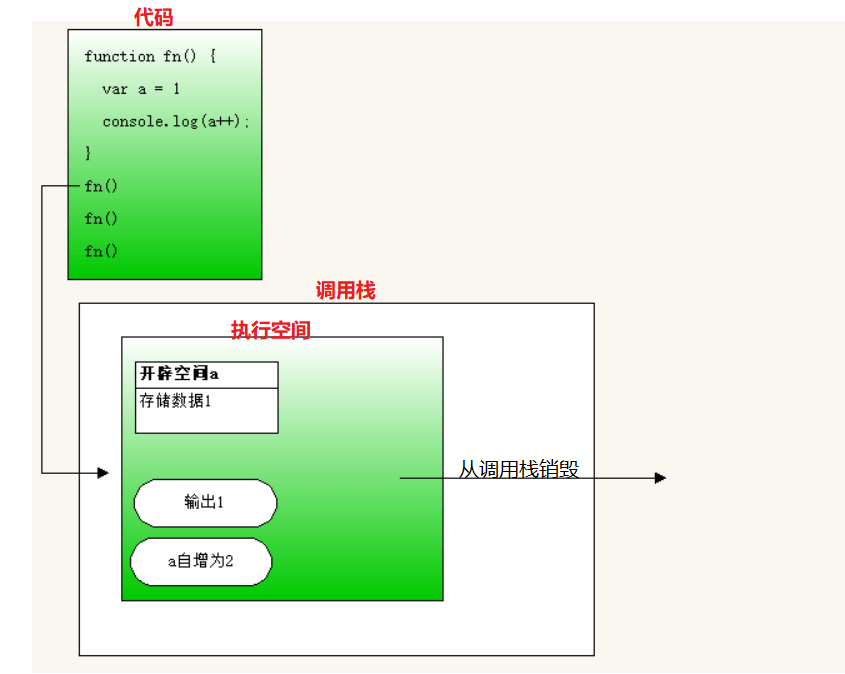
这个过程重复了3次。所以每次输出都是1。
闭包的执行过程如下图:
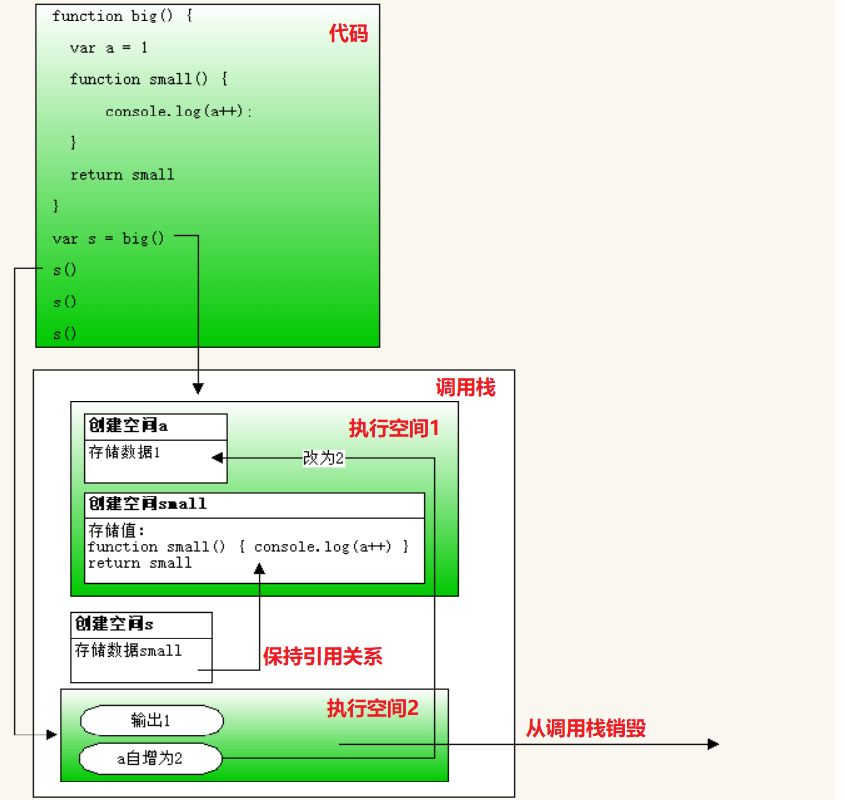
全局s要和执行空间1中的small保持引用关系,全局s要在后面也能使用,所以执行空间1中的small不能被销毁,所以执行空间1也不能销毁。
所以第二次调用的时候,输出的还是执行空间1中的变量a,是第一次修改后的值2。
3、闭包的好处
- 保护私有变量不被全局污染
- 间接的让函数外可以访问函数内的变量
- 延长了变量的生命周期
外面函数每调用一次,就会在调用栈保留一个执行空间,调用多了话,可能会造成内存溢出/内存泄漏
4、闭包的应用
4.1、循环中使用异步或事件
1
2
3
4
5
6
7
8
9
10
11
12
13
14
15
16
17
| <ul>
<li>javascript修炼内功</li>
<li>vue修炼独孤九剑</li>
<li>react修炼乾坤大挪移</li>
</ul>
</body>
<script>
var lis = document.querySelectorAll('li')
for(var a=0; a<lis.length; a++) {
lis[a].onclick = click(a)
}
function click(a) {
return function() {
alert(lis[a].innerText)
}
}
</script>
|
4.2、防抖
有一些事件,触发的频率特别高,往往我们在网页中动了一下,事件就会触发很多次,例如:鼠标移动事件、键盘按下事件、浏览器滚动事件、浏览器大小改变事件、文本框及时改变内容事件等。或者人为的频繁触发事件,例如:滑动轮播图,在第一张图还没有完全滑动过去,就点击了多次按钮来触发滑动行为。
这些频繁触发的事件,往往我们不需要触发太多次数,多个动作中,只需要触发一次或几次,而不是每次都触发。
防抖:指事件在频繁的触发时,函数只执行一次。
获取最后一次执行的结果:
1
2
3
4
5
6
7
8
9
10
11
12
13
| document.onmousemove = debounce(fn, 1000)
function debounce(handler, time) {
var timer = 0
return function() {
clearTimeout(timer)
timer = setTimeout(() => {
fn.call(this, ...arguments)
}, time)
}
}
function fn(e) {
console.log( e.pageX );
}
|
获取第一次执行的结果:
1
2
3
4
5
6
7
8
9
10
11
12
13
14
15
16
17
18
19
| document.onmousemove = throttling(fn, 1000)
function throttling(handler, time) {
var flag = true
var timer = 0
return function() {
if(flag) {
handler.call(this, ...arguments)
flag = false
} else {
clearTimeout(timer)
timer = setTimeout(() => {
flag = true
}, time)
}
}
}
function fn(e) {
console.log( e.pageX );
}
|
4.3、节流
节流:事件在频繁触发时,不是每次触发都会执行函数,让函数有节制的执行。也就是让函数在一个时间段内虽然触发了多次,但是函数只执行了一次。
利用时间差节流:
1
2
3
4
5
6
7
8
9
10
11
12
13
14
| document.onmousemove = throttling(fn, 1000)
function throttling(handler, time) {
var startTime = +new Date()
return function() {
var now = +new Date()
if(now - startTime >= time) {
handler.call(this, ...arguments)
startTime = now
}
}
}
function fn(e) {
console.log( e.pageX );
}
|
使用定时器和开关节流:
1
2
3
4
5
6
7
8
9
10
11
| function throttling(handler, time) {
var flag = true
return function() {
if(!flag) return
flag = false
setTimeout(() => {
handler.call(this, ...arguments)
flag = true
}, time)
}
}
|
4.4、函数柯里化
如果一个函数调用传递了多个实参,函数定义就需要多个形参来接收。函数柯里化,就是让函数不接收全部的实参,只接收部分参数,然后在函数内再次返回一个小函数,来接收剩余部分的参数,让函数整个运行流程,可以分多个步骤执行。例:
正常函数:
1
2
3
4
5
| function add(a, b) {
console.log(a + b)
}
add(1, 2)
|
柯里化后的函数:
1
2
3
4
5
6
7
8
9
| function add(a) {
return function(b) {
console.log(a + b)
}
}
var fn = add(1)
fn(2)
add(2)(3)
|
二、继承
1、继承的概念
继承是让一个对象可以拥有另一个对象的属性和方法,而不用自己去添加,类似于原型和实例对象的关系。
面向对象编程,有一个特性就是继承。
2、原型继承
我们可以通过修改对象的原型,让对象能拥有其他对象的属性和方法。例:
1
2
3
4
5
6
7
8
9
10
11
12
13
14
15
16
17
18
19
20
21
22
23
24
25
26
| function Animal() {
this.name = '动物'
}
Animal.prototype.sport = function() {
console.log('运动');
}
var animal = new Animal()
console.log(animal);
function Bird() {
this.wing = '翅膀'
}
Bird.prototype = animal
Bird.prototype.fly = function() {
console.log('飞翔');
}
var bird = new Bird()
console.log(bird);
console.log(bird.name);
bird.sport()
|
弊端:继承来的属性在原型上,不在自己上,当给自己添加同名属性时,就无法使用原型的属性了。
3、借用函数继承
通过借用函数,可以在子构造函数中,执行父构造函数中的代码,将父构造函数中的属性添加在子构造函数中。
1
2
3
4
5
6
7
8
9
10
11
12
13
14
15
16
17
18
19
20
21
22
23
24
25
| function Animal() {
this.name = '动物'
}
Animal.prototype.sport = function() {
console.log('运动');
}
var animal = new Animal()
console.log(animal);
function Bird() {
Animal.call(this)
this.wing = '翅膀'
}
Bird.prototype.fly = function() {
console.log('飞翔');
}
var bird = new Bird()
console.log(bird);
console.log(bird.name);
bird.sport()
|
弊端:父构造函数原型上的方法,bird实例对象无法使用。
4、组合继承
为了解决原型继承和借用函数继承的弊端,可以将这两种继承方式都使用上。
1
2
3
4
5
6
7
8
9
10
11
12
13
14
15
16
17
18
19
20
21
22
23
24
25
26
27
28
| function Animal() {
this.name = '动物'
}
Animal.prototype.sport = function() {
console.log('运动');
}
var animal = new Animal()
console.log(animal);
function Bird() {
Animal.call(this)
this.wing = '翅膀'
}
Bird.prototype = animal
Bird.prototype.fly = function() {
console.log('飞翔');
}
var bird = new Bird()
console.log(bird);
console.log(bird.name);
bird.sport()
|
5、ES6的类
高级编程语言,都有面向对象编程,面向对象编程,要有专门的创建方式,在以往的js版本中,使用构造函数来创建。函数本身具有自己让代码复用的功能,再加上创建对象外,反而让js语言显的比较混乱,所以es6增加了专门用于定义对象的数据:类。
类是抽象的对象,对象是实例化的类。所有对象都是由类衍生的,例如人,具体的说,张三这个人,是从人类中衍生的,将人类具体化以后得到的。人类是众多具体的人抽象画后的概念。
ES6中定义类的语法:
类只有一个作用,就是定义对象,定义对象的语法:
类的本质,其实还是一个函数,只是换了一种形式,这种形式只能用来定义类,而不能当做构造函数调用了。
1
2
3
4
5
6
| class Animal{
name = '动物'
}
console.log(Animal);
console.log(typeof Animal);
Animal()
|
此时对象是空对象,要给对象中添加属性,就要在类中定义:
1
2
3
4
5
6
7
| class 类的名字{
属性名 = 值
constructor() {
this.属性名 = 值
}
}
|
在new类的时候,传递的实参,其实是传递给了constructor,contructor方法只会在new类的时候执行一次。
给对象添加方法:
1
2
3
4
5
| class 类的名字{
方法名() {
代码段
}
}
|
类中写好的方法,默认会出现在对象的原型中。
例:
1
2
3
4
5
6
7
8
9
10
11
12
13
| class Animal{
name = '动物'
constructor(age) {
this.age = age
this.say = '叫'
}
sport() {
console.log('运动');
}
}
var a = new Animal(5)
console.log(a)
|
输出结果:
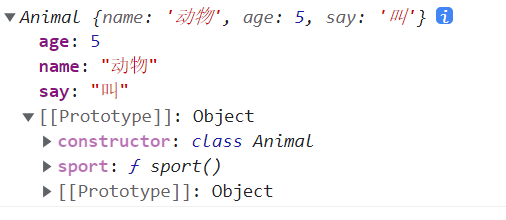
例:利用es6的类写tab切换和轮播图。
6、ES6的继承
在ES6的类中定义的对象,实现继承有继承的语法:
例:
1
2
3
4
5
6
7
8
9
10
11
12
13
14
15
16
| class Animal{
name = '动物'
constructor(age) {
this.age = age
this.say = '叫'
}
sport() {
console.log('运动');
}
}
class Bird extends Animal{}
var b = new Bird()
console.log(b);
|
输出结果:
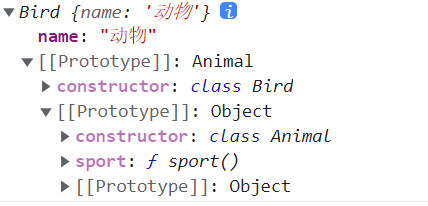
跟组合继承的效果是一样的。
如果子类中有constructor方法的话,必须在constructor中的第一行代码调用super方法,否则会报错。
1
2
3
4
5
6
7
8
9
10
11
12
13
14
15
16
| class Animal{
name = '动物'
sport() {
console.log('运动');
}
}
class Bird extends Animal{
constructor(age) {
this.age = age
}
}
var b = new Bird(12)
console.log(b);
|
报错:

1
2
3
4
5
6
7
8
9
10
11
12
13
14
15
16
17
| class Animal{
name = '动物'
sport() {
console.log('运动');
}
}
class Bird extends Animal{
constructor(age) {
super()
this.age = age
}
}
var b = new Bird(12)
console.log(b);
|
如果父类中有constructor,super就相当于在调用父类的constructor,例:
1
2
3
4
5
6
7
8
9
10
11
12
13
14
15
16
17
18
19
20
21
| class Animal{
name = '动物'
constructor(say) {
this.say = say
}
sport() {
console.log('运动');
}
}
class Bird extends Animal{
constructor(age, say) {
super(say)
this.age = age
}
}
var b = new Bird(12, '叫')
console.log(b);
|
结果:
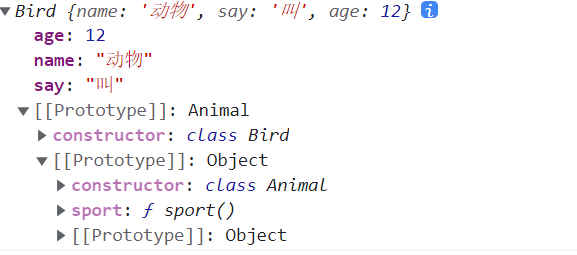
继承自父类的方法和属性,子类是可以重写的(覆盖):
1
2
3
4
5
6
7
8
9
10
11
12
13
14
15
16
17
18
19
20
21
22
23
24
| class Animal{
name = '动物'
constructor(say) {
this.say = say
}
sport() {
console.log('运动');
}
}
class Bird extends Animal{
constructor(age, say) {
super(say)
this.age = age
this.name = '鸟'
}
sport() {
console.log('飞翔');
}
}
var b = new Bird(12, '叫')
console.log(b);
|
结果:
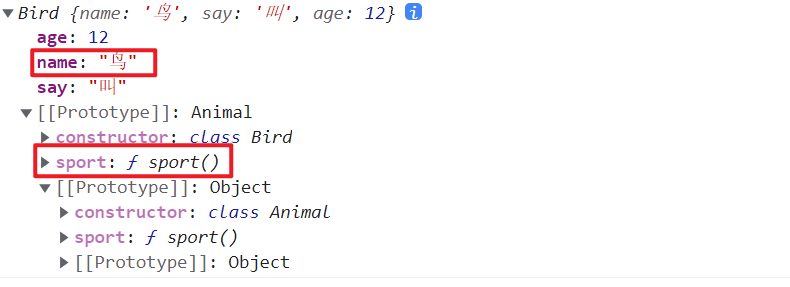
这样就可以说,同一个父类,可以被多个子类继承,但每个子类都可以在同样的属性和方法中有不同的表示显示。用专业术语来将,叫做多态。


















